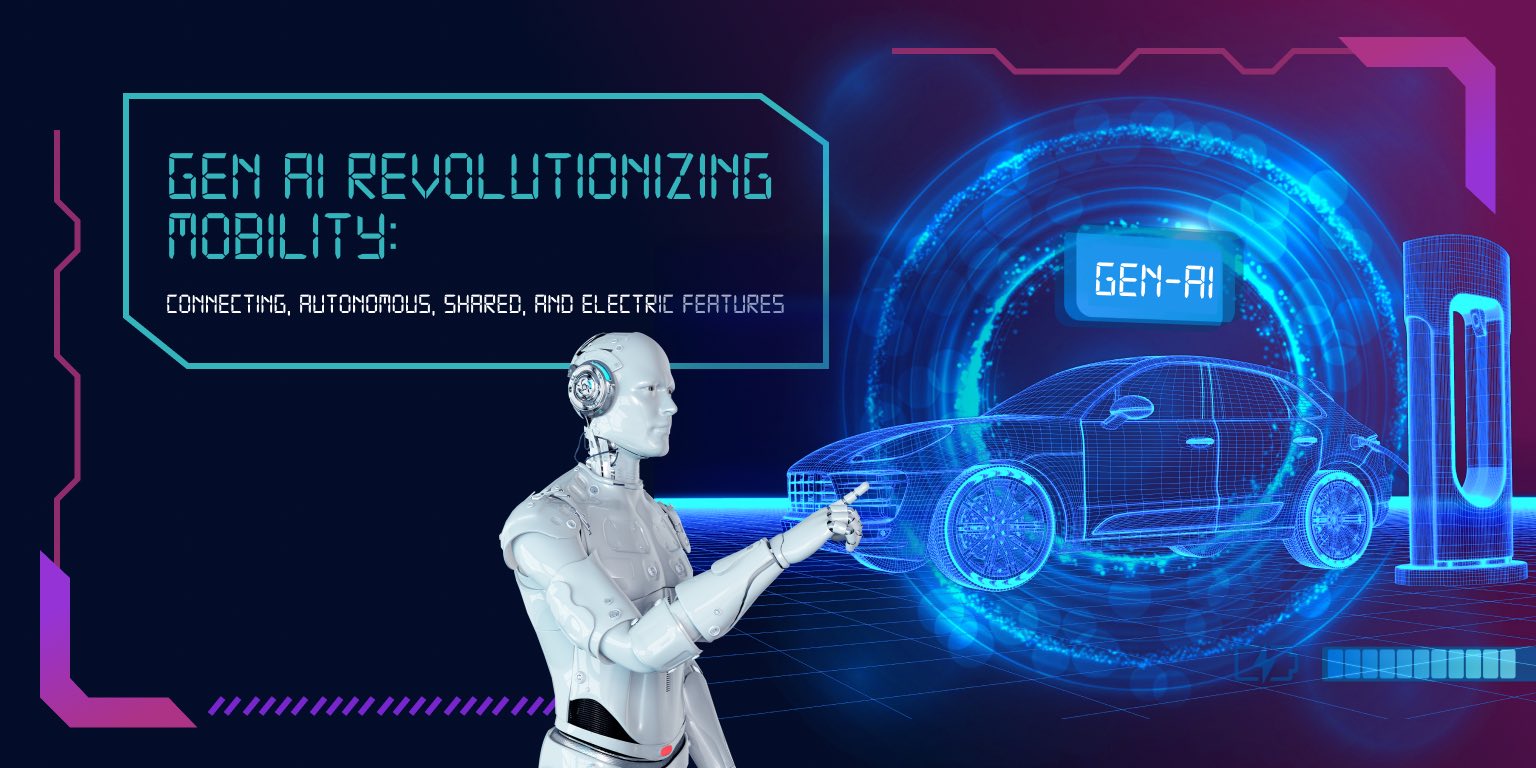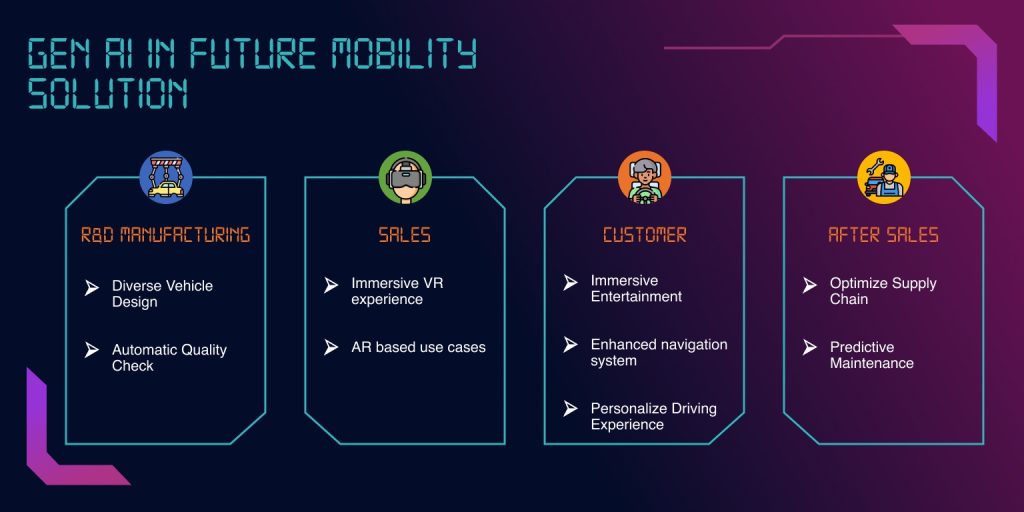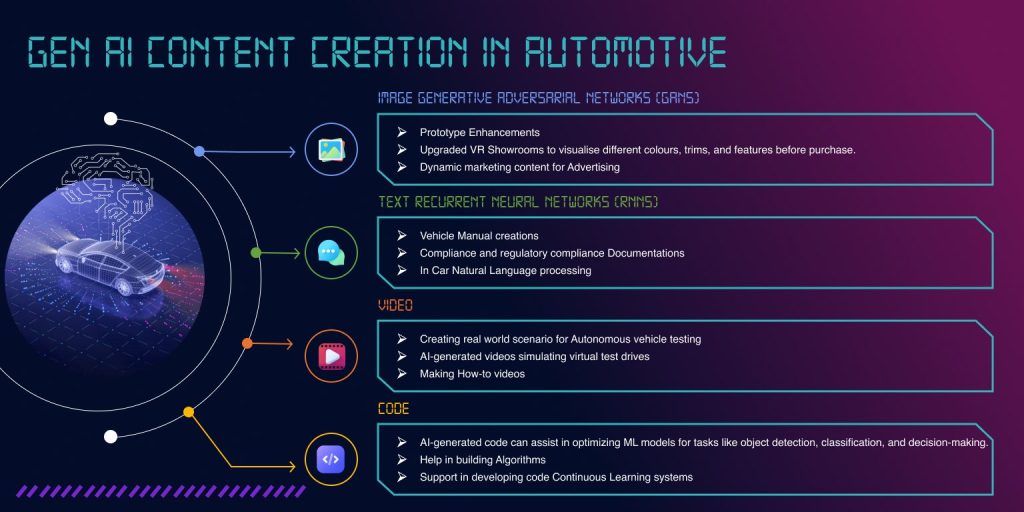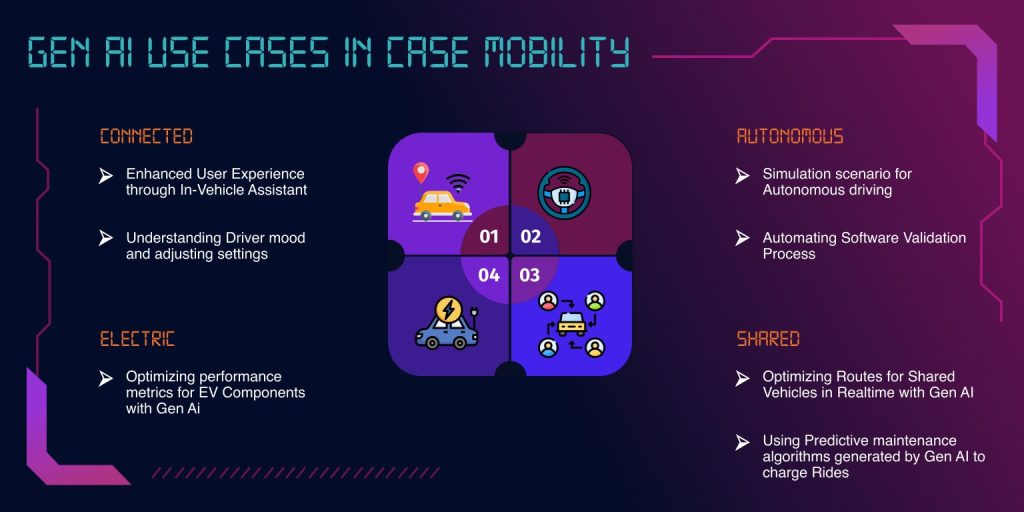Gen AI Revolutionizing Mobility: Connected, Autonomous, Shared, and Electric Features

Gen AI, an advanced form of artificial intelligence, has been instrumental in revolutionizing the landscape of transportation and mobility. In this article let us explore how Gen AI’s capabilities have significantly impacted the Automobile Industry, especially in areas of Connected, Autonomous, Shared, and Electric mobility (CASE) sectors, shaping a more sustainable, efficient, and technologically advanced future.
Why Gen AI?
Gen AI is artificial intelligence capable of producing highly realistic and complex images, videos, audio, and text that mimic human creativity. Its systems often utilize advanced machine learning techniques, such as deep learning and neural networks, allowing them to adapt and learn from data in more sophisticated ways compared to older AI models. This results in improved accuracy, efficiency, and the ability to handle complex tasks.
They excel in natural language processing, understanding nuances, context, and even emotions within text or speech data, enabling more human-like interactions.
It enables more sophisticated automation, leveraging algorithms to make complex decisions based on extensive datasets. This has led to improvements in areas such as autonomous vehicles, predictive analytics, and automated customer service.
With increased focus on ethical AI, Gen AI frameworks often emphasize fairness, transparency, and accountability in their design and decision-making processes.
This addresses concerns related to bias, privacy, and ethical implications that were less emphasized in older AI systems.
Gen AI influence in various Automotive functions

One of the most rewarding use cases for generative AI in the automotive industry is design and engineering. Generative AI can help designers and engineers to deliver new concepts. Additionally, they help improve their development cycles and enhance existing designs with the help of intelligent insights. In practice, generative AI can create intelligent 3D models of vehicles based on simple prompts or a series of rudimentary sketches. This can offer an efficient, time-saving tool to help designers build more comprehensive concepts. Additionally, it helps them visualise their ideas more effectively. Generative AI can also optimise vehicles’ performance and safety by testing various configurations and parameters.
Customers are more inclined towards great user experience than ever, and this is where AI contributes the most to success. Customization of AI features and tools is very much possible with the use of AI for manufacturing. The freedom for each customer to personalize their vehicle makes the purchase more interesting and attracts more people for market growth. This trend toward personalization is reflective of a broader social push for a more seamless and efficient purchasing process. Considering ongoing supply chain issues and delays, consumers are becoming less patient when it comes to selecting and receiving their goods. To ensure a high-quality customer experience, car manufacturers can simplify their decision-making process.
Gen AI in Automotive Content Creation: Uses and Impact
Generative AI techniques are employed in various ways within the automotive industry, utilizing different methods to address specific challenges and tasks. Here are several generative methods and their applications in automotive.

Image generation
Generative Adversarial Networks (GANs) aids in design, prototyping, and virtual showroom experiences. GANs can create synthetic images of vehicles for marketing/Advertising.
Video Generation
Leveraging video generation technology in the automotive industry offers diverse opportunities to enhance marketing, customer engagement, education, and visualization of vehicles and related services, providing immersive and informative experiences for both consumers and industry professionals.
Text Generation
Gen AI-powered text generation in the automotive industry improves customer interactions, marketing efforts, technical documentation, training materials, and compliance, ultimately enhancing the overall customer experience and streamlining various processes across the automotive value chain.
Code Generation
By leveraging Generative AI for code generation in the automotive sector, companies can streamline development processes, enhance safety and efficiency, and accelerate innovation in vehicle technology.
Generative AI helps in coding complex algorithms for perception, decision-making, and control systems in autonomous vehicles. Generating code with AI helps in
- Integrating data from various sensors (lidar, radar, cameras) to create a comprehensive perception system for Autonomous cars.
- Ensures compliance with safety standards such as ISO 26262,
- Guaranteeing vehicle safety and regulatory adherence
Gen AI Revamps CASE mobility

The above picture shows light on some key use cases which are my top picks among various other use cases. Let’s discuss in detail the role of AI in each segment:
Connected Mobility with Gen AI
Gen AI’s role in connectivity within cars transforms them into intelligent, connected entities capable of seamless communication, data utilization, and personalized experiences, ultimately enhancing safety, convenience, and efficiency for drivers and passengers alike.
It contributes to sophisticated infotainment systems, providing personalized content, navigation, and entertainment options based on user preferences. Integrating Gen AI-powered NLP [ Natural language processing] allows drivers to interact conversationally with the car’s systems, enabling hands-free control over entertainment, navigation, and other functions.
It also facilitates V2X communication, enabling cars to interact with other vehicles, traffic infrastructure, pedestrians, and emergency services, enhancing safety and traffic efficiency.
So how exactly the Gen AI enrich customer experience over conventional AI solutions? Some key examples as below
- Utilize Gen AI to develop intuitive and interactive infotainment systems within the car. These systems could include Holographic projectors, touchscreens, gesture controls, or voice commands powered by AI for seamless interaction.
- Virtual Companion Through a Holographic Projector, you can make any human-like design or favourite character to answer your queries over the ride. To be a great companion for Solo riders and riders with kids in Car. This will be the future of In-car touchpoints powered by LLM.
- Collaborate with entertainment content creators, game developers, or media companies to leverage Gen AI in creating exclusive, innovative, and captivating experiences for in-car entertainment.
Autonomous Mobility Revolution
Creating a simulation scenario for autonomous driving using Gen AI involves designing a virtual environment that mimics real-world conditions and challenges. Validate the performance of autonomous vehicles in different scenarios, iterate on the simulation to introduce new challenges, and continually refine the system based on the simulation outcomes.
Gen AI’s contributions to autonomous vehicle development are limited now because Traditional reinforcement learning algorithms might struggle when dealing with large action spaces due to exploring all possible actions becomes computationally expensive or impractical.
“Large Action Models” (LAMs) are designed to handle such scenarios by efficiently managing or approximating the action space, allowing the agent to effectively learn and make decisions.
LAMs help optimize decision-making by efficiently handling vast action spaces. They enable vehicles to navigate complex scenarios by selecting appropriate actions from a large set of possibilities. In reinforcement learning for autonomous vehicles, exploring a wide range of actions is essential for learning optimal behaviour. LAMs facilitate effective exploration strategies, allowing the vehicle to learn and improve decision-making over time without exhaustively exploring all possible actions, which can be impractical in real-world settings.
It can assist in addressing ethical dilemmas, enabling vehicles to make ethical decisions in critical situations, prioritizing safety and minimizing harm. It also helps in the validation process, generating data and simulations required to certify the vehicle’s safety and reliability for public roads.
Shared Mobility and Gen AI
Gen AI’s optimization in ride-hailing services significantly enhances efficiency, reliability, and user satisfaction by leveraging data-driven decision-making, personalized experiences, and predictive analysis within shared mobility environments.
It assists in dynamic pricing strategies by analysing supply-demand dynamics, traffic conditions, and other variables in real-time. It helps ride-hailing platforms optimize fare structures, implementing surge pricing during high-demand periods and encouraging drivers to operate in areas with increased demand.
Electric Mobility Transformation
By leveraging machine learning, predictive analytics, and data-driven insights, Gen AI accelerates innovation in EV technology, facilitating more efficient designs, better-performing batteries, accurate range estimations, and the development of a robust charging infrastructure. These advancements collectively contribute to the growth and adoption of electric vehicles while addressing challenges related to range anxiety, battery performance, and charging accessibility.
Gen AI contributes to enhancing BMS (Battery Management System), which monitors and manages battery health, temperature, and performance. It optimizes charging and discharging cycles, prolonging battery life and ensuring safety. AI-driven research assists in developing new battery chemistries and materials that increase energy density, improve charging times, and reduce costs.
It analyses various data sources, including driving patterns, weather conditions, terrain, and battery health, to predict EV range accurately. It considers multiple variables to provide more precise range estimations to drivers, aiding in better trip planning.
Gen AI contributes to the development of smart charging networks that manage power distribution efficiently, minimize grid stress during peak demand, and offer dynamic charging solutions.
Overcoming Adversity: Forging a Path to Future Potential
Addressing ethical concerns and privacy issues associated with Gen AI-driven mobility solutions requires a collaborative effort among policymakers, technology developers, and stakeholders. Implementing transparent practices, ensuring data protection measures, fostering inclusivity, and establishing clear ethical guidelines are critical steps toward navigating challenges while leveraging the benefits of AI in mobility responsibly, some major challenges for implementing Gen AI:
- Privacy Issues: Gen AI relies on collecting vast amounts of user data. Safeguarding this sensitive data against breaches or cyberattacks becomes crucial, as any compromise could lead to privacy violations and identity theft.
- Ethical Decision-making: Gen AI influences decisions during unexpected scenarios, raising questions about how these vehicles prioritize between different ethical dilemmas (e.g., choosing between passenger and pedestrian safety in an unavoidable accident).
- Algorithm Bias and Fairness: Gen AI algorithms might inject biases present in historical data, leading to discriminatory outcomes in service access, such as biased route planning or unequal service distribution.
Closing Thoughts
Gen AI is fundamentally reshaping the landscape of connected, autonomous, shared, and electric mobility, illustrating its pivotal role in defining the future of transportation. Its ability to foster connectivity, autonomy, operational efficiency, and sustainability heralds a future where transportation becomes smarter, more inclusive, and easily accessible. This technological advancement holds the promise of a safer, more environmentally friendly, and convenient transportation system for everyone.
Via Connected Services, OEMs initiated the accumulation of diverse datasets sourced from vehicle users, automobiles, and the surrounding environment. As per Mckinsey the overall revenue pool from car data monetization at a global scale might add up to USD 450 – 750 billion by 2030. Gen AI’s capabilities in processing and analysing car data offer opportunities for generating value from the vast amount of information vehicles produce. However, it’s crucial to prioritize data privacy, security, and ethical considerations when leveraging car data for monetization purposes.
In conclusion, Gen AI’s utilization in CASE Mobility presents promising avenues for Original Equipment Manufacturers (OEMs) to create value and capitalize on monetization opportunities. McKinsey’s report forecasts a significant shift, with an estimated 36-41% of automotive revenue expected to come from car data-enabled services and shared mobility by 2030. This underscores the pivotal role of Gen AI in driving transformative changes within the automotive industry.
About Author:

Muthukumaran Mahalingam, Deputy General Manager – Connected Car & Services, Renault Nissan Tech.
He is passionate about software products and services. he has been developing products using cutting-edge technologies and novel ideas to attain customer delight. He is an expert in providing Smart Mobility Solutions for Connected Vehicles and enthusiasts in CASE Mobility.

